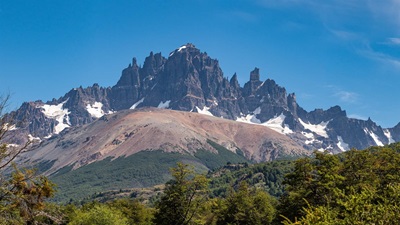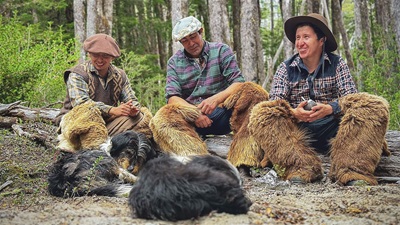Efforts for the Conservation and Sustainable Development of Chilean Patagonia

Overview
Located nearly 620 miles (1,000 kilometers) from Antarctica, Chilean Patagonia is renowned for its scenic beauty, which is maintained with little human intervention. The region is a vast tapestry of unique geographic and ecological conditions, ranging from imposing granite mountains, volcanoes, and dense ancient forests to fast-flowing, glacier-fed rivers and a coastline consisting of more than 40,000 islands. This unusual connectivity between land and sea helps make Chilean Patagonia’s landscapes and waters exceptionally productive and ecologically diverse.
Although the region features a massive network of protected areas, these vital places don’t have appropriate levels of funding or management, jeopardizing the effective safeguarding of the areas.
Pew and the Chilean Patagonia project
The Pew Charitable Trusts is a nongovernmental, nonpartisan, nonprofit organization that uses data to make a difference, addressing the challenges of a changing world by illuminating issues, creating common ground, and advancing ambitious strategies that lead to tangible progress.
Pew seeks to help safeguard Chilean Patagonia by supporting the creation of new land, marine, and freshwater protected areas; improving the management of existing ones; and strengthening local communities’ involvement in creating and managing protected areas.
Why Chile?
Chile’s geography gives it a high level of biodiversity. Thanks to its 2,653 latitudinal miles (4,270 kilometers), the Andes mountain range in the east, the Atacama Desert in the north, and the Pacific Ocean in the west, Chile has 88 of the 110 ecosystems known to exist on the planet.
Protected areas cover 42% of the country’s ocean and 21% of its land mass. But almost all of these protected areas lack basic management mechanisms and the budget necessary to fund such management efforts. What’s more, Chile is in the bottom 10 among countries worldwide in terms of national spending on biodiversity.
When protected areas are well managed, they provide benefits to the surrounding communities that facilitate sustainable development—such as ensuring access to safe, plentiful drinking water and recreational spaces; safeguarding local culture; protecting against natural disasters; and even offering new sources of tourism-associated employment.
Faced with these challenges and opportunities, Pew has aligned its work—which includes technical support to improve the management of protected areas—with Chile’s efforts to achieve goals linked to the Paris Agreement, the Nationally Determined Contributions, and Goal 3 of the Global Biodiversity Framework, which seeks to ensure that at least 30% of ecosystems are conserved and managed effectively by 2030.
New Biodiversity and Protected Areas Service
Chile’s recent creation of a new government agency, the Biodiversity and Protected Areas Service (SBAP), presents an excellent opportunity to safeguard the country’s ecosystems through management and greater financing. SBAP will manage Chile’s 242 public protected areas, as well as any future protected areas. And it will also introduce conservation techniques into nonprotected areas, including management of threatened ecosystems, ecological restoration and wetlands inventories, plans for threatened and invasive species, and economic incentives to promote sustainable practices.
But although the law that created SBAP increased the budget for protected areas, a substantial gap remains between the current funding level and what’s needed to manage protected areas appropriately.
How does Pew work in Chile?
As part of a public-private collaboration, Pew provides technical and financial support to local, national, and international civic organizations with a recognized track record in conservation to enhance the work they have developed over the years in Patagonia. In addition, through collaboration agreements with universities, Pew seeks to promote the development of research that allows communities, managers, and authorities to make decisions based on scientific evidence.
Similarly, Pew has supported local governments’ role in managing protected areas through the pioneering Gateway Communities Protected Areas Strategy Group, which brings together three of Chilean Patagonia’s regional governments, 26 municipalities, and various public agencies.
Pew has also supported efforts by CONAF, Chile’s national forest service and protected areas agency, to improve protected area management—for example, by helping to bring Chile in alignment with international standards for management and conservation practices, such as the International Union for Conservation of Nature’s Green List.
These improvements stem from research and data to help the national government plan for the management of protected areas; collaborate on the design and implementation of the world’s largest government platform for monitoring biodiversity; support citizen participation in managing protected areas; and create and support the country’s first protected areas academy, which will be housed at the Universidad Austral de Chile and could eventually be replicated in other countries as well.
In addition, through the Universidad Austral de Chile’s Austral Patagonia Program, Pew helped establish a training plan for teams of park rangers, regional and central support professionals from CONAF, members of Indigenous and local communities, and municipal and regional officials.
Likewise, Pew supports collaborative efforts driven by communities and local governments to create new protected areas on land and at sea—in addition to protecting Patagonia’s rivers, which are not currently protected—by balancing local development with the protection of nature and cultural practices and traditions.
Through its work with local officials and community members, Pew works to ensure that Chile’s protected areas receive the management and financing they deserve—which, in turn, would ensure not only the protection of a country with some of the most diverse ecosystems on the planet but also sustainable development that would help nearby communities continue to thrive.









